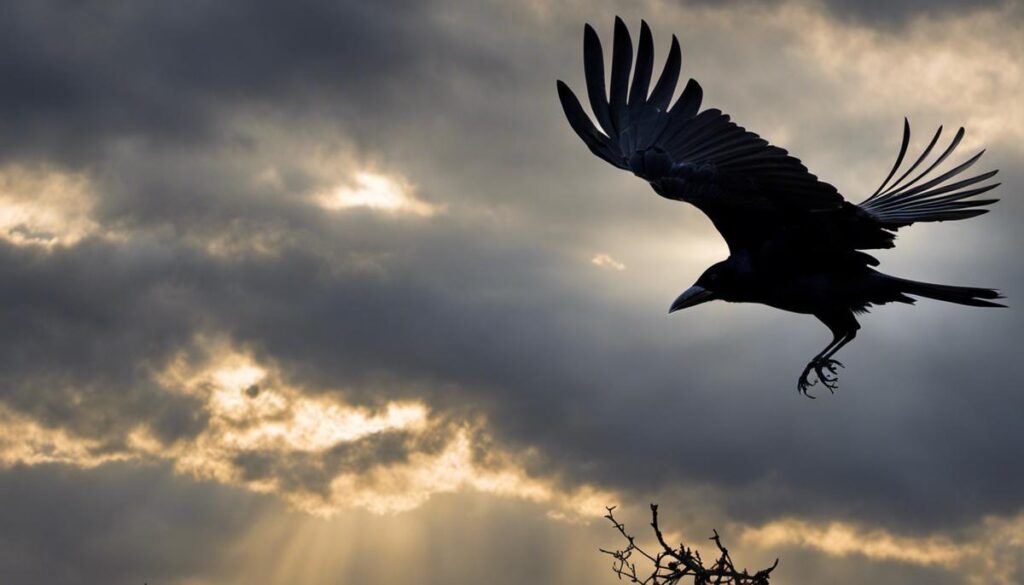With their enigmatic presence and striking color, crows have long tantalized the human imagination, inspiring fear, respect, and endless interpretation across cultures. This fascination carries into the realm of dreams, where the crow’s symbolism can hold a multitude of meanings – ominous, divine, or even transformative. Among these interpretations, the biblical perspective of crows evokes an intriguing layer of mystery, replete with theological undertones and historical nuances. Yet, understanding this perspective requires not just an exploration of scripture, but also a comparison with cultural interpretations and modern psychology theories on dream analysis. In this multifaceted dissection, we delve into the dark wings of crow symbolism, hoping to shed light on what it might mean when these intriguing birds perch on the dreamscapes of our slumber.
Historical Context and Symbolism of Crows in the Bible
Crows in Biblical Lore: Portrayal and Symbolism
Regarded as one of the most intelligent avians, crows have managed to engrave themselves into the fabric of various cultures worldwide. Their enigmatic presence has echoed through literature, art, folklore, and notably, in one of the world’s most influential texts – The Bible. By delving into various books within the Bible and drawing on extensive studies of biblical ornithology, we can begin to understand the diverse symbolism embedded in the biblical depiction of crows.
In the Old Testament, crows solidify their initial appearance in the narrative of Noah’s Ark within the Book of Genesis (Genesis 8:7). Noah dispatched a crow, or sometimes translated as a raven, to perceive if the flooding had rescinded. Unlike the dove that Noah subsequently released, the crow did not return with tangible evidence of land, thus symbolizing an undomesticated, lawless aspect of nature. Scholarly interpretations often cast the crow in this instance as a harbinger, communicating an unwelcoming, barren world post-deluge.
Nevertheless, crow portrayals in the Bible are not solely negative. Their resilience is lauded in Job (Job 38:41) and Psalms (Psalms 147:9), where God is credited with providing food for crows, aligning them with divine sustenance. The proficient survival skills of crows serve as metaphors for divinely managed providence, furthering the numinous significance of these birds.
Deepening the complexity of biblical crow symbolism, Leviticus and Deuteronomy categorize the crow as an ‘unclean creature,’ mainly due to their omnivorous and scavenging nature. At the same time, the Proverbs (Proverbs 30:17) paints a rather daunting image of crows plucking out the eyes of disrespectful children- a narrative warning of sacrilege.
Furthermore, the New Testament extends the representation of crows beyond the Judaic law’s constraints. In Luke (Luke 12:24), Jesus employs the symbolism of the crow, here translated as a raven, to underline the theme of divine providence – “Consider the ravens: they neither sow nor reap, they have neither storehouse nor barn, and yet God feeds them.” This allegorical usage of crows elevates them to an emblem of the Lord’s unwavering care for all creatures, signifying His divine munificence.
Similarly, the Gospel of Saint John (John 21:20-23) presents a crow’s cry as a prophetic augury, announcing the death of Peter, thus transcending the earthly realm, demonstrating the crow as a harbinger of destiny.
Analyzing a crow’s biblical depiction allows the uncovering of a wide gamut of symbolism, warding off simplistic interpretations often associated with these resilient birds. It is clear that crows, in their biblical appearances, project attributes of ferocity, divine provision, cleanliness, prophecy, and knowledge of destiny, reflecting their role as liminal beings between the human and the divine.
Thoroughly exploring the biblical text unearths the multifaceted symbolism of crows, celebrating them not merely as creatures of survival but of abundant spiritual fascination and potential. In understanding these contexts, future research can expand upon deciphering the enigmatic symbolism of these and other birds within biblical lore and beyond. Through such efforts, we further our understanding of the natural world’s profound impact on culture, spirituality, and literature.
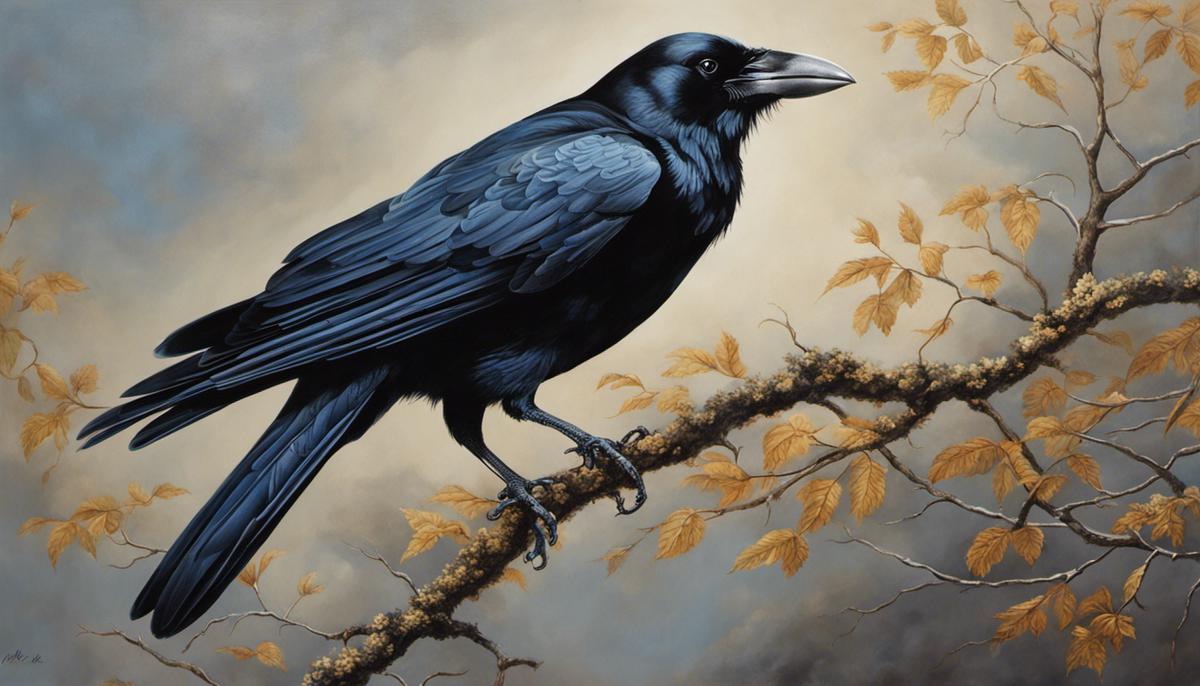
Interpreting Dreams in a Biblical Context
Four distinct markers characterizing biblical texts and traditions on dream interpretation seamlessly emerge: divine antechamber, consciousness conduit, interpretative power, and prophetic foretelling.
Biblical narratives, particularly those of Old Testament, position dreams as divine antechambers, junctions between the mortal and the divine. This interaction is palpable in Jacob’s dream at Bethel, where God’s covenant is reiterated in a vision, transmuting nocturnal images into divine dialogue (Genesis 28:10-22). Dreaming thus prevails as intimate communion, an opportunity for divinely orchestrated glimpses into the celestial realm.
Beyond celestial interaction, dreams enshrine themselves as conduits for deeper self-consciousness within biblical texts. This is beautifully encapsulated in King Solomon’s dream in Gibeon (1 Kings 3:5-15), in which, in his slumber, his latent discerning wisdom and thirst for justice rise to consciousness through divine interaction. Dreams therefore traverse beyond the realm of divine encounters, providing a mirror for humans to reflect, introspect, and acknowledge their inner selves and potential.
Biblical texts also acknowledge the imperative of interpretative power in dreams’ assessments. Joseph’s experiences in Egypt (Genesis 40-41) underscore this, his ability to interpret dreams proving pivotal in his personal advancement and Egypt’s survival in famine. The Book of Daniel further extends this view, presenting dream interpretation as a divine gift (Daniel 1:17). Critical here is the assertion that dreams are not just individual divine-human communication or consciousness conduits, but carry broader societal and communal implications needing adept interpretation.
Lastly, dreams within biblical texts serve as prophetic foretelling, offering foresight into future events, both personal and universal. This foresight is evident from Joseph’s sheaf and celestial dreams signifying future dominance (Genesis 37:5-11) to Pharaoh’s dream of emaciated cows and scorched grain, which Joseph interprets as seven years of impending famine (Genesis 41:14-36). Importantly, prophetic dreams offer an instrument to act upon knowledge of future events.
Although biblical texts and traditions frequently present dreams encased within nuance and symbolism, the four threads identified here offer a comprehensive canvas of dreams’ function and interpretation. They serve as divine antechambers, conduits for consciousness, reveal the significance of interpretative power, and operate as prophecy tools. Close reading of biblical dream narratives, therefore, invites a richer understanding of not just dreams, but also the biblical perception of human-divine interaction, introspective consciousness, prophetic wisdom, and divine guidance.

Comparative Analysis of Crow Symbolism in Different Cultures
Given the extensive symbolism that crows carry in the biblical tradition, their portrayal in other cultural traditions offers illuminating contrasts and parallels. The crow, as a ubiquitous figure in myriad global mythologies, carries complex layers of meaning that transcend its physical form.
In Native American tradition, notably among the Plains tribes, crows represent wisdom and insight, believed to possess an almost supernatural level of intelligence. They are honored as carriers of ancient knowledge, and their appearance in dreams is often interpreted as a call to explore the mysteries of life deeper.
Contrarily in Norse tradition, Odin, the god of wisdom and war, is accompanied by two crows, Huginn (thought) and Muninn (memory). Here, crows are not merely symbolic entities, but enablers of divine wisdom, a clear departure from the Biblical portrayal of crows. The crows fly over the world daily, returning to Odin with news, thereby suggesting an intimate relationship between the crow, wisdom, memory, and the divine.
In Irish mythology, the Morrigan, a goddess of war and fate, is often depicted as a crow. Crows in this context are associated with battlefields and serve as guides for souls to the afterlife. A clear parallel emerges between these streams of mythology where crows carry implications of not only death but also the transition to new phases of existence, akin to the Biblical interpretation of the crow as a creature marking prophetic transitions.
China’s symbology presents yet another facet of crow representation, associating it often with filial piety. The crow, according to popular legend, brings food to its impaired parents, symbolizing care and respect, in stark contrast to the Proverbs’ warning in the Bible.
Japanese folklore, yet again, grants the crow divine status, with the sun goddess Amaterasu employing a three-legged crow, Yatagarasu, as a beacon. Negating the ‘unclean’ images of Leviticus and Deuteronomy, this crow represents divine intervention and guidance.
Thus, it is evident how divergent the cultural tradition’s interpretations of crows can be. From being ‘unclean creatures’ to being associated with divine wisdom, intelligence, war, death, transition, respect and guidance, their symbolism varies greatly. Such examination illuminates the importance of cultural context, revealing how the same creature, the crow, can hold an array of meanings, each deeply embedded in the societal, metaphysical, and spiritual milieu from which they emerge.
This exploration underscores the necessity of continued scholarship in this field, where even a creature as common as the crow can offer profound insight into the philosophies, beliefs, and the very fabric of different cultures. Such richness of interpretation, grounded in deep understanding and analysis, elevates the study of symbolic entities, like the crow, from mere taxonomy to a journey of discovery into the human condition and its varied expressions across time and space.
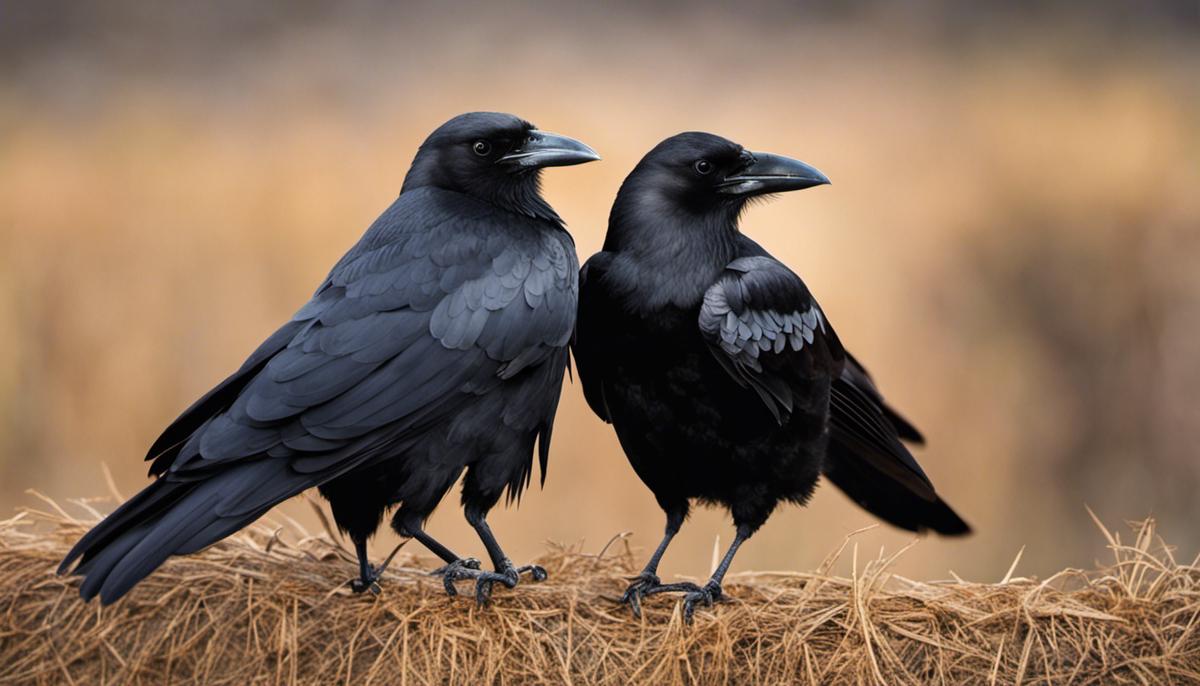
Modern Psychology’s Perspective on Dream Interpretation of Crows
Upon turning towards contemporary psychology, it is essential to understand that dreams are an integral part of unconscious processing, aiding in problem solving, memory consolidation, and emotional regulation. The depiction of crows in a dream, hence, may hold multiple interpretations.
Carl Jung, the Swiss psychiatrist and psychoanalyst who founded analytical psychology, developed the concept of archetypes — universally inherent, unlearned, and instinctual patterns that shape human behavior and symbols in our dreams. The crow or raven, according to Jung, represents the shadow self, or the dark side of one’s personality that is often repressed in the conscious mind. Therefore, dreaming of crows might suggest a need or desire to understand and reconcile with these shadow aspects, leading to an acceptance and integration of the seemingly adverse characteristics.
Concurrently, the visibility of crows within dreams may also be an indicator of potential transformation. Famed for their remarkable intelligence and adaptability, crows could symbolize a capacity or necessity for evolution or change in the dreamer’s personal life, a metaphor for personal growth and development, toward a more complex and refined state of being.
Additionally, psychologists have viewed the appearance of these majestic black birds in dreams as an emblem of a message that needs to be deciphered. On a more individual level, crows can be seen as symbols of a deep-seated intuition, or subconscious insight that one must pay heed to. It may represent hidden truth that can only be accessed via introspection or deep self-exploration.
In light of Cognitive psychology, dreams about crows could also be a result of recent experiences, observations, or thoughts related to these creatures rather than holding any profound symbolic significance. Cognitive dream theorists emphasise the continuity between waking and sleeping cognition, positing that the content of dreams often reflects the dreamer’s thoughts, concerns, and experiences from their waking life.
While it is enticing to derive profound, universal interpretations of dream symbolism, it is important to approach such analysis with caution. The context dependent, subjective nature of dreams demands personalized interpretation rather than one-size-fits-all meanings. The appearance of crows in dreams, just like any other symbol, must be interpreted within the context of the dreamer’s life. Factors such as personal experiences, thoughts, feelings, and associations with crows will have substantial influence on the interpretation.
Accumulatively, the vast quilt of interpretations of crows in dreams—ranging from divine augury, carriers of wisdom to the manifestation of shadow self, facilitators of transformation and messengers of subconscious intuition—underscores the rich psychological, cultural, and spiritual intersectionality woven into the fabric of human consciousness. Such psychological insights not only deepen our understanding of dreams and their symbolism, but they also unfurl new avenues for cognitive and emotional introspection. Thus, the study of dreams, symbols, and their interpretations continues to be an essential realm in both scientific exploration and personal growth.
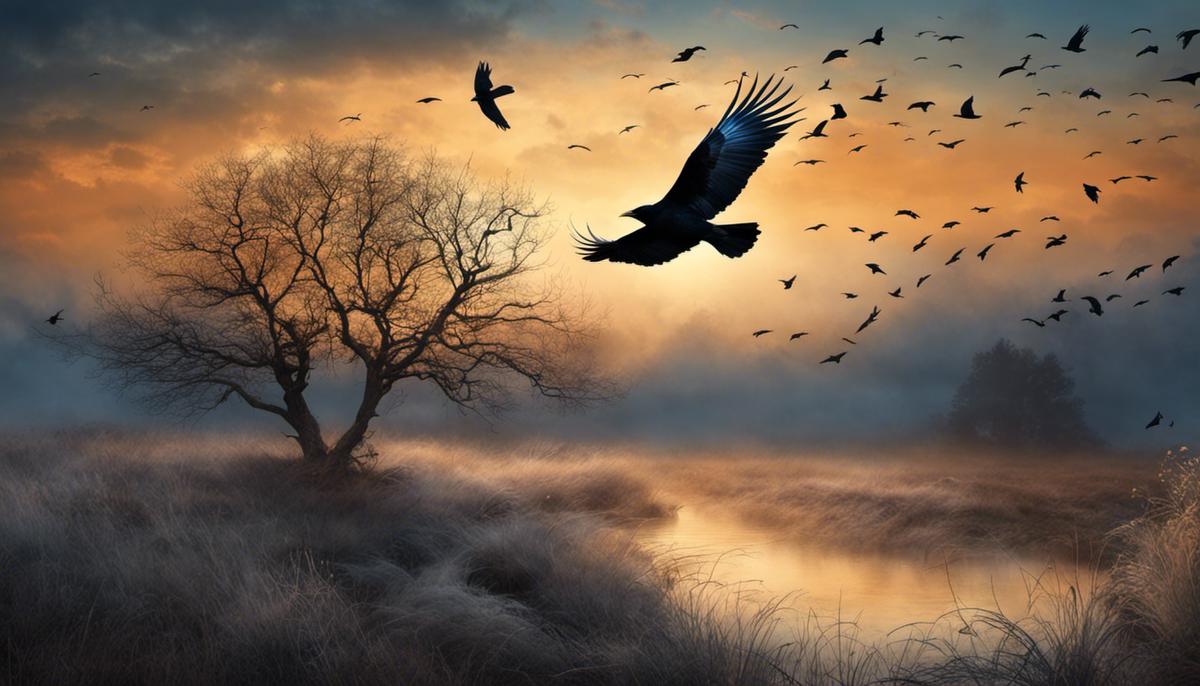
Case Examples of Dreams Featuring Crows
Modern psychoanalysis offers several interpretations of dreams involving crows. Sigmund Freud, one of the most influential figures of 20th-century psychology, often emphasized crows as markers of repressed desires. These avian figures, when appearing in dreams, may symbolize hidden wishes and camouflaged intents. Following this, when a dream involving crows is met, a psychoanalyst’s helper might direct attention towards the exploration of concealed aspects of a dreamer’s psyche.
Similarly, Alfred Adler, one of Freud’s earliest associates, interpreted dreams as problem-solving devices. To Adler, a crow in a dream might represent a daunting task or situation that needs imminent attention. A dreamer witnessing crows might be subconsciously grappling with some obstacle or working to surmount an issue.
An important notion to consider is the scientific approach to dreams, which leans towards the biological functions of dreams. Neuroscience asserts the possibility of dreams serving various purposes like memory consolidation or removal of unimportant day-to-day experiences, where crow symbolism doesn’t necessarily carry any psychological or spiritual implication. Instead, the appearance of crows in dreams may simply be a product of everyday exposure or neural reverberation.
In the realm of transpersonal psychology, crows in dreams could represent a bridge towards transcendental experiences. Transpersonal psychology, which draws from various spiritual traditions, infers that a crow, as an archetypal symbol, might guide the dreamer towards self-actualization and spiritual growth, hinting at integral lessons of life and inspiring profound personal and spiritual metamorphosis.
Crows also appear prominently in the work of Carl Gustav Jung, another Galen of psychoanalysis and student of Freud. Jung took a different approach to dream interpretation than his prior academic association, tending to see dreams as revealing more about an individual’s future than repressed past. Furthermore, Jung considered crows as symbols of the ‘shadow’—the unconscious aspects of personality—in Jungian symbolism, a crow, therefore, might represent the dark aspects of the self that need to be acknowledged and integrated into the individual’s conscious life.
From an anthropological perspective, the symbol of a crow in a dream carries direct cultural implications. For instance, in some African cultures, dreaming of a crow might indicate imminent threats or upcoming tumults due to their associated symbolism with witchcraft and sorcery.
In conclusion, dreams and their interpretative symbolism, especially those featuring crows, can be complex and multifaceted. They are influenced by a vast range of factors including one’s cultural background, personal experiences, spiritual beliefs, and mental state. Dream science is an extremely challenging and fascinating area of study. The interpretation of the symbol of a crow in dreams takes more than just map-reading through cultural, religious, and psychology-based understanding—it requires an open mind, attuned intuition, and a deep sensitivity towards the inner realms of the dreamer’s psyche.
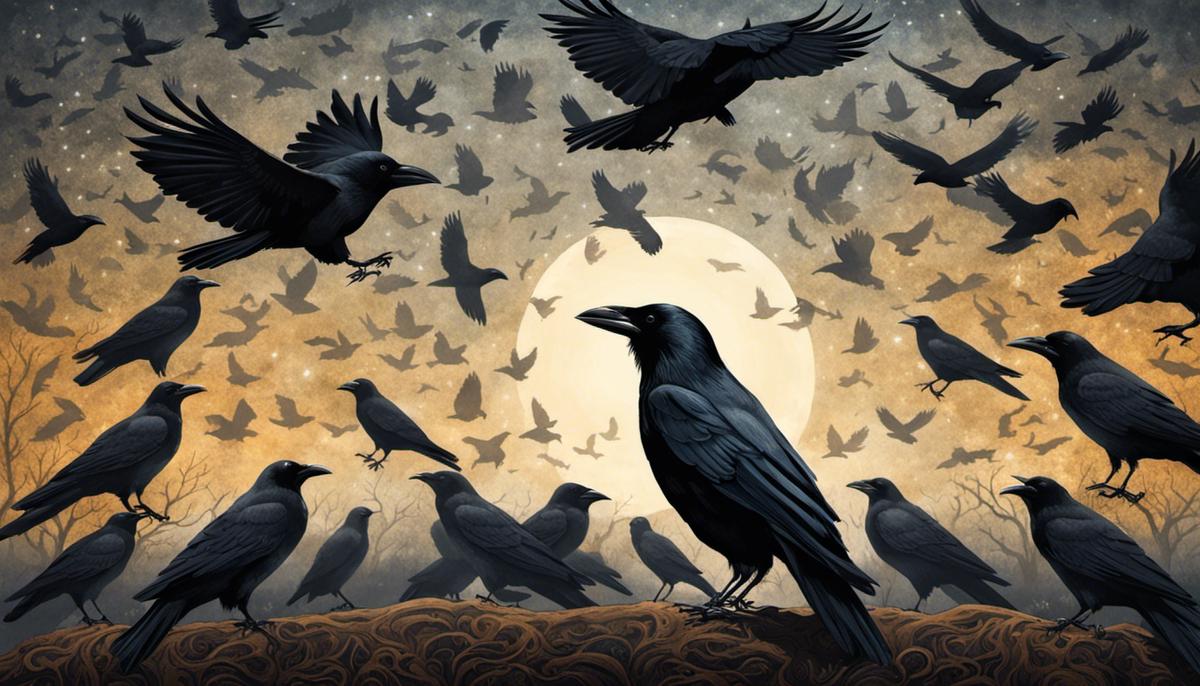
Ultimately, the crow, whether in wakefulness or in dreams, continues to captivate with its dynamic symbolism. Within the biblical context, it quivers with divine messages and warnings, and yet resonates with unique interpretations in different cultural settings. The interplaying shadows of ominous and divine significations, anchored against the backdrop of modern psychology, offer a layered, complex understanding worthy of its subject. As we navigate our dreams, encountering a crow can indeed shape the narrative of our unconscious process, its meaning uncovered through a balanced blend of biblical, cultural and psychological interpretations. Despite their sometimes ominously portending image, crows might not always signify an impending doom, but serve as fascinating guides into the multi-dimensional world of dream interpretation.

